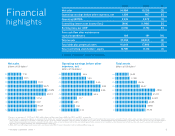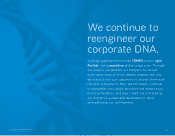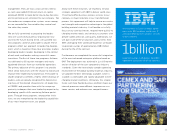Cemex 2012 Annual Report Download - page 18
Download and view the complete annual report
Please find page 18 of the 2012 Cemex annual report below. You can navigate through the pages in the report by either clicking on the pages listed below, or by using the keyword search tool below to find specific information within the annual report.
UNFCCC accreditation for new
initiatives
In 2012, we successfully obtained the United Na-
tions Framework Convention on Climate Change
(UNFCCC) accreditation for five new initiatives as
Clean Development Mechanisms (CDM), includ-
ing projects in the Dominican Republic, Mexico,
and Colombia. Overall, our full CDM portfolio now
includes 13 ocially registered projects for a to-
tal carbon offset potential of 1.76 million tons of
CO2 emissions per year. In addition, CEMEX has
four Verified Carbon Standard (VCS) projects in
the U.S., one of which has already been registered
in Louisville, Kentucky, and has a total reduction
potential of almost 300,000 tons of CO2 annually.
-23%
Net specific CO2 emissions reduction
from our 1990 baseline
ocially registered projects
by the UNFCCC as Clean
Development Mechanisms
13
19902012
Carbon Disclosure Project recog-
nized CEMEX for Best Disclosure
and as a top ten performer in
its 2012 Latin America Climate
Change Report
Louisville Plant, USA
Wind turbines at Madison Quarry in California, USA
Development Certificates) on the Mexican stock ex-
change. The proceeds from this offering will be invested
in a series of energy projects in Mexico, beginning with
the construction of the Ventika wind-powered energy
park in the northern state of Nuevo Leon. With a minor-
ity equity stake not exceeding 10%, our primary role will
be to provide technical expertise for the development of
projects sponsored by the Fund.
Consistent with our carbon reduction strategy, we
continue our efforts to replace clinker with alternative
cementitious materials—many of which are derived
from the waste of other industries—such as fly ash,
a combustion residue from coal-fired power plants,
blast furnace slag, a by-product of pig iron production,
and pozzolan, a fine, sandy volcanic ash. In 2012, our
overall clinker factor (the ratio of clinker content to total
cement production) was 76%, down from 84% in 1990.
Thanks to these and other low-carbon initiatives, we
are on track to achieve our target of a 25% reduction in
specific CO2 emissions per ton of cement by 2015 from
1990 levels. Indeed, as compared with our 1990 base-
line, at the end of 2012, we had achieved a reduction
of approximately 23% in our specific net CO2 emissions
per ton of cement produced. As a result, this year we
avoided 7.8 million metric tons of CO2 emissions—includ-
ing emissions avoided through the EURUS wind farm in
Mexico. This is equal to the emissions generated by 1.5
million vehicles per year.
18
< previous I contents I next >
























